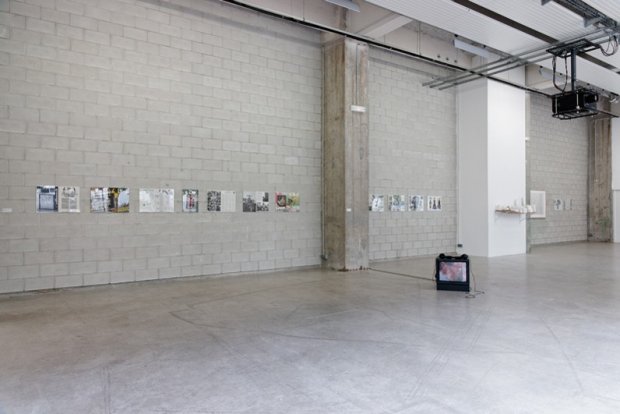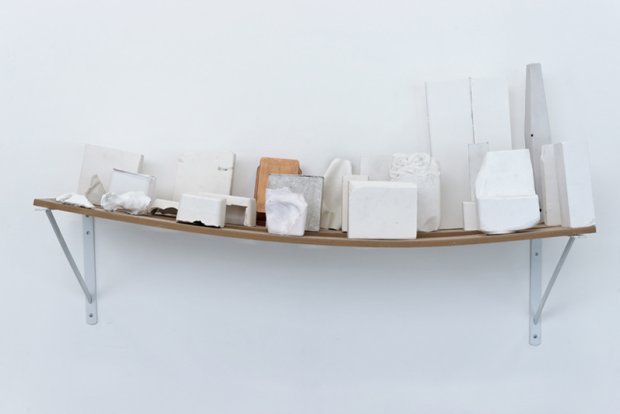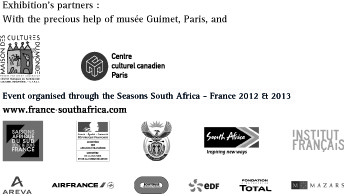Something More Than a Succession of Notes

- Exhibition view "Something More Than a Succession of Notes". Bétonsalon - Center for Art and Research, Paris, 2013. Image: Aurélien Mole
Ada Magazine, William Anastasi, Amar Foundation, Willem Boshoff, Ian Carr-Harris, Alice De Mont, Ruy Guerra, Johnny Kit Elswa, Shirley, Douglas and Tam Krenak, Violaine Lochu, Ignazio Macchiarella, Pénélope Patrix, Taller Leñateros, Andrew Norman Wilson
Curator: Mélanie Bouteloup
In 2003, UNESCO established a Convention for the Safeguarding of the Intangible Cultural Heritage, offering unprecedented institutional recognition of practices in the order of know-how, oral traditions, gestures, or ritual. According to this convention, the notion of “intangible cultural heritage” designates the “practices, representations, expressions, knowledge, skills - as well as the instruments, objects, artefacts and cultural spaces associated therewith” - transmitted from generation to generation by a community. These practices exist in states of permanent recreation in measure with the interaction of the group with its milieu, its history, and provide “a sense of identity and continuity, thus promoting respect for cultural diversity and human creativity”. This convention testifies to the evolution of the concept of “heritage” towards a broader definition, no longer strictly monumental and western. Beyond monuments, objects and texts, this concept now includes oral traditions and gestures, recognizing the diversity of forms of cultural expression throughout the world. The ambition to assure their preservation, however, poses difficulties. How to envisage the representation of practices that are intangible? How to undertake their “safeguarding” without freezing them within an inventory, and reducing them to a transcription or a reactivation necessarily partial and subjective? Should we finally “conserve” these intangible practices, or give free reign to their mutations?
On the occasion of the tenth anniversary of this convention, the exhibition Something More Than a Succession of Notes [1] proposes an interrogation of the concerns raised by the patrimonialization of cultural good that are by definition living and in perpetual evolution. Attempting to classify and perpetuate intangible cultural practices, is this not to go against the grain of the organic movement which underlines them, proper to the constitution, to the evolution, and the disappearance of expressive forms belonging to a human community? In as much as the products, knowledge and rituals of a group are always born and transformed in accordance with a precise socio-economic context, their concretization in a timeless form supposed to be representative (by means of sound recordings, photographs and videos, as well as testimonials and elements collected in the field), cannot take full account of their variations and their strong ability to change.
The question of the preservation of intangible cultural practices is complex and presents many obstacles. The desire for memory and representation which it implies involves, first off, the risk of leading to their folklorization and commodification. These practices generally represent a touristic challenge for the concerned area; becoming a platform for economic interests, if not political and nationalist ones, they are gradually distanced from the communities by which they are practiced, and reduced to derivative products which flourish on the market - in contradiction with the very notion of intangible cultural heritage. Moreover, the undertaking of their representation by an institution - a process that involves sampling representative elements from a given reality in order to study and exhibit them - runs the risk of decontextualization and reification. In a reversal of the classical model of the museum whose purpose is to conserve, valorize, and present to the public tangible heritage, the aim today is thus to find ways of approaching the intangible dimensions of cultures, and conceiving of a museology able to embody their plurality. A significant number of ethnographic and natural science museums, such as The Royal Museum for Central Africa of Tervuren, in Belgium, the Humboldt Museum of Berlin, and the MUCEM in Marseille, are currently engaged in a redefinition of the museum as site for the exhibition of living practices [2]. With the aim of avoiding the decontextualizing effect of the museum space, they are working to make way for the historical, economic and social elements that contribute to explain the emergence of a practice, its nature and function.
Following from the exhibition "One Caption Hides Another" which in 2012 addressed the ethical, political and legal questions raised by the restitution of ethnographic objects, Something More Than a Succession of Notes extends the reflection on our relation to the culture of the Other, by investigating the modes and limits of its documentation. Each occurrence of a tradition, a ritual, or of a gesture is unique, and will never be repeated identically. Therefore, any tangible record that the researcher may produce from it can be but a representation that is necessarily partial, in both sense of the word: the sound or written recordings of a song will indeed never provide a translation of accompanying gestures, nor of the interpersonal relationships of its interpreters, and will remain but a single example among an infinite number of possible interpretations. The anthropologist Jack Goody, who focused his work over many years on the transcription of Bagre song in Ghana, thus underlines in a volume of the journal Museum International dedicated to intangible heritage: “Transcription is not a neutral event. […] The shift of a spoken recitation into a written text is not merely a matter of recording what has been said. The actual process changes the nature of the work by giving a permanent shape to something that is otherwise undergoing continuous change, by providing visual line endings and sentence endings to what were possibly slight pauses in the performance, by eliminating the musical, gestural and vocal accompaniments [3].”
Facing the impossibility of objectively representing and interpreting that which has a life of its own, the exhibition Something More Than a Succession of Notes takes on the role - like certain currents in contemporary anthropology - of assuming the complete subjectivity of the transcriptions at play in the presented works. It makes a note of the incoherence that we fall upon in dividing human cultures into one “tangible” side and another “intangible” one - while in practice certain elements said to be “material”, such as costumes, are inseparable from the “intangible” practices to which they are associated. At the intersection of Anthropology, History, Art and Museology, the exhibition brings together contributions from researchers, activists and artists whose works and researches affirm the irreducible singularity of the intangible cultural practices. Far from any type of classification that risks producing a simplification and normalization of these practices, the exhibition Something More Than a Succession of Notes on the contrary shapes itself as pluralist and polyphonic. Sketching a museology of many voices coming both from communities, researchers and creators, the exhibition glides from the field of anthropology to that of art - united here by the observation, the recording of the real, the subjectivity of their viewpoint, and the deep variability of their subject matter.

- Exhibition view "Something More Than a Succession of Notes" with Alice De Mont, "Study, test block, test shelf, test room", 2011. Bétonsalon - Center for Art and Research, Paris, 2013. Image: Aurélien Mole
[1] Ignazio Macchiarella, « Sauvegarder l’oralité ? Le cas du canto a tenore », in Chiara Bortolotto (dir.), Le patrimoine culturel immatériel, Enjeux d’une nouvelle catégorie, 2011
[2] See the international conference “The Postcolonial Museum: the Pressures of Memory and the Bodies of History”, which took place in Naples on February 7 and 8, 2013 as part of the European research project, European Museums in an Age of Migrations (MeLA).
[3] Jack Goody, « The Transcription of Oral Heritage », Museum International n° 221/222, Paris : Éditions Unesco, Mai 2004, pp. 93 - 98.

Share